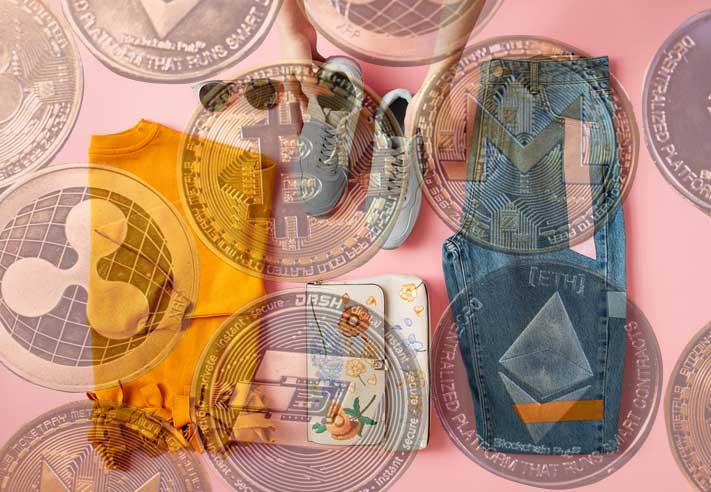The intellectual property (IP) licensing has gone a long way with the pace of technology…
Role Of NFTs In The Fashion Industry: An Overview
Introduction

What are NFTs?
Non-fungible tokens, or NFTs, are cryptographic assets generated using blockchain technology. It enables the exchange of value through a non-replicable medium. It has the ability to be a one-of-a-kind and unrepeatable token that cannot be split but may be used to represent real or virtual world things, as well as the token’s own qualities and ownership, all while remaining within a blockchain representation. This endows NFTs with the unique qualities that make them so desirable. NFTs are created using “smart contracts,” which are software codes that govern actions such as validating ownership and regulating their transferability. When someone produces an NFT, they write the underlying smart software code that regulates the NFT’s properties and adds those properties to the NFT’s accompanying blockchain.
NFTs and Intellectual Property Rights
With all the opportunities that NFTs present for a business, there is also the inevitable opportunity for misuse of a business’s or brand owner’s intellectual property rights held in any underlying asset through the minting of unauthorized NFTs. Copyright infringement arises when a reproduction right is infringed (i.e. the restriction against reproducing or copying copyright works) or communication right is infringed. (i.e. the restriction against communicating copyright works to a new public not originally envisaged by the copyright owner). Trademark infringement may arise where an unauthorized party mints an NFT linked to the underlying asset, without the asset owner’s permission, and advertises, offers for sale, and/or sells the NFT using the asset owner’s registered trademarks.
The purchaser of an NFT does not obtain all of the underlying intellectual property rights to the work linked with the NFT. The buyer’s specific intellectual property rights are determined by the terms of the license agreement linked to the sale. Ownership of an NFT as a unique token must be distinguished from ownership of the material to which that NFT may be attached. When someone buys an NFT connected to a piece of material, they don’t get the intellectual property rights to that content automatically. Ownership is only transferred if the author of the original work expressly provides for it and consents to it, just as it is with copyright transfers. Without such an express provision, the buyer of an NFT acquires an implied non-exclusive license to display the associated media in its electronic wallet solely for personal use, but does not own the underlying copyrights in the content with which the NFT is associated, nor does he or she have the right to display such media on any third-party product, website, or platform.
Role of NFTs in the Fashion Industry
In recent years, the fashion and beauty sectors have made a concerted effort to promote an accurate and fair understanding of business changes in order to reinforce new phrases that are in line with current business practices. Fashion’s only hope of getting back on the fast-paced digital train was the development of NFTs, as it had completely missed the boat with E-commerce. When e-commerce initially appeared on the scene, a large percentage of firms were entirely uninterested in pursuing the new channel. Since then, the fashion industry has grown far more careful. Gucci has offered new products as an NFT last year, including one-of-a-kind sneakers. Even premium watch brands are promoting NFT auctions through the many social media platforms accessible. NFT 2.0 is here to stay, and there’s no end in sight. In March 2019, an original thought arose from the buzz surrounding blockchain technology as it spreads across key industries like the arts and entertainment. The item was the idea of three brands: Dapper Labs, a digital couture company, and Johanna Jaskowska, whose iridescence is a digital outfit that was eventually sold on blockchain for the US $9,500, and then top luxury brand LVMH Mot Hennessy in May of the same year. Louis Vuitton, the owner of some of the world’s most recognizable fashion labels including Fendi, Dior, and Givenchy, was the first to use blockchain-based tokens to ensure an item’s authenticity. The Aura platform was created by partnering with Microsoft and Consensys (a blockchain software business). It’s a blockchain-based system that lets customers track the origins and lifespan of their purchases. After conducting a study on the subject at the Fashion Institute of Technology, it is possible to make a compelling case that this knowledge is the most valuable to customers in today’s customer-centric environment. The usage of NFTs by luxury brands to reach out to high-net-worth individuals. These tokens may now be used by luxury fashion firms like LVMH to interact with customers in a unique way, communicate their experiences, and reflect their values. Customers in this day and period are more inclined to patronize a company that interacts with them through the use of a story behind the product, according to research. When it comes to younger millennials and Gen Z market segments, sustainable fashion and beauty is major motivator. NFTs enables premium brands to provide customers with one-of-a-kind, valuable experiences, which will increase brand awareness, engagement, and sales. However, despite the obvious benefits, fashion has yet to figure out the best method to incorporate NFTs.
What are the possible positives and negatives of NFTs in the Fashion Industry?
An NFT can create virtual fashion products as a designer and distinct as actual products, addressing the issue of digital clothing replication. NFT expands the range of unique items available. It could be used by a fashion business to sell its own show footage or personalized backstage images. When it comes to digital copies, the NFT makes it easy to track down the original copy that a collector would want to buy. NFT might have an impact on the resell market not only by maintaining an accurate map of changes in ownership of a specific item but also by paying companies a royalty every time their product is sold in the second-hand luxury market, for example. In brief, the notion that a digital item can be as distinctive as a physical one is intriguing for fashion since it allows brands to monetize their digital assets and extends their control over the product beyond the sale.
On the other hand, despite their obvious benefits, NFTs are still a relatively new asset class that may present buyers with unforeseen obstacles. Some difficulties to be aware of and looked into more before buying NFTs i.e., anyone might snap a photo of the artwork, upload it to a blockchain, and sell it, therefore buyers must verify that they are buying NFTs from the artist or that the seller has the permission to sell the NFT. NFTs by themselves are unable to link an NFT’s creation or ownership to a real person in the physical world or to validate that the NFT’s creator holds the underlying rights to associate that NFT with a specific creative work. Despite the fact that NFTs can authenticate the work and the chain of ownership, the problem remains that if the original ledger record is fraudulent or has flaws from the start, NFTs merely affirm and perpetuate that deception, therefore counterfeiting will occur in the world of NFTs as well. Furthermore, depending on how many times the artist sells that item, the value of your purchase could be diluted. Therefore, it is important to define the worth of what is being purchased per the contract, and see if that varies whether you buy one of the first ten in a series or the hundredth. Finally, if you buy something, you must know its value so that you can include it in your tax returns and insurance policy. As this new asset class develops, laws, IRS guidelines, and insurance policies change, and they may disagree with you on the value of your NFT.
Legal Battle: Hermès International, et al. v. Mason Rothschild [1:22-cv-00384 (SDNY)].
Hermès, whose original physical Birkin bags range from $9,000 to $500,000, recently filed a lawsuit against the individual behind the collection of 100 MetaBirkins non-fungible tokens (“NFTs”) that include images depicting furry renderings of its famous Birkin bag, on January 14, 2022. Hermès claims that MetaBirkins founder Mason Rothschild is a “digital speculator who has infringed on the brand MetaBirkins for use in creating, marketing, selling, and facilitating the exchange of digital assets known as non-fungible tokens,” which simply “rip off Hermès” famous BIRKIN trademark, by adding the generic prefix “meta”, which refers to “virtual worlds and economies” where digital assets such as NFTs can be traded and sold.
The defendant, according to Hermes, has been infringing on its trademark by utilizing @MetaBirkins on social media handles and “the totality of the Birkin mark in hashtags, including #MetaBirkins and #NotYourMothersBirkin,” which is commercial in nature and contradicts Rothschild’s claims of fair use. Hermes also claims that Rothschild’s use of its trademarks, such as MetaBirkins NFTs, infringes on its trademarks, as such unauthorized use is “likely to cause confusion and mistake in the minds of the purchasing public, and, in particular, falsely creates the impression that the goods sold by Rothschild are authorized, sponsored, or approved by Hermès when, in fact, they are not.” Rosthchild’s “willful and purposeful” actions “dilute the distinctive quality of the BIRKIN Mark and the goodwill connected with it,” according to the lawsuit.
Under New York General Business Law, Hermès asserts allegations of federal and common law trademark infringement, false designation of origin, trademark dilution, cybersquatting, and injury to business reputation and dilution. The company is seeking monetary damages, including Rothschild’s profits, as well as injunctive relief to prevent him from using its trademarks in any way, including “using any reproduction, copy, counterfeit, or colorable imitation of Hermès’ Federally Registered Trademarks to identify any goods or the rendering of any services not authorized by Hermès.”
While enforcing against the unauthorized use of protected content in NFTs is largely the same as enforcing against any other online infringement, and brand and content owners can seek relief directly from the usual suspects, such as website operators, ISPs, registrars, and so on, this case will inevitably raise some novel and interesting questions, particularly in terms of remedies, given that the infringing goods at issue are NFTs and thus are stored on the blockchain. It is because blockchain transactions are connected to every previous transaction record, records cannot be modified after they have been entered; however, there is a procedure through which an NFT can be transmitted to an unreachable address, presumably erasing its value.
Furthermore, if the court orders Rothschild to block access to the MetaBirkins NFTs, this will likely raise questions about the individual proprietors of the allegedly infringing NFTs. Since the decision has not yet been made, it is important to note that if Rothschild continues to advertise and sell NFTs under the MetaBirkins brand, and builds a company that offers a range of virtual products and services under the MetaBirkins brand, it will eventually preempt Hermès’ ability to offer products and services in virtual marketplaces that are uniquely associated with Hermès and meet “Hermès’ quality standards.”
Legal Implications of NFTs in India
The Copyright Act of 1957 is India’s most important piece of legislation on the issues of Copyright. The copyright will exist in works such as original literary, dramatic, musical, and creative works; cinematograph films; and sound recordings, according to Section 13 of the aforementioned Act.
One of the concerns related to NFTs is whether NFT qualifies as a work that can be copyrighted in India, based on the above-mentioned category of works. A video clip or a sound recording, for example, may qualify as a work that can be copyrighted under this Act, but what about a GIF, or even a picture or a tweet? A tweet or a GIF might not qualify as a work capable of being copyrighted if we properly follow the Copyright Act. At the moment, it appears that not all NFTs are eligible for copyright, making it difficult for owners to claim copyright on NFTs. As a result, there is a pressing need to broaden the scope of works that can be copyrighted under Indian law.
Another issue is that it’s unclear whether NFTs constitute “contracts” under the Indian Contract Act of 1872 or as derivatives under the Securities Contract (Regulation) Act of 1956. If NFTs are classified as the latter, they are prohibited from being exchanged, traded, sold, or bought.
Another problem is that NFTs are digital collectibles with limited rights, and they rarely transfer copyright ownership to a holder unless contractually agreed upon. If a copyright license is obtained from the copyright owner, an NFT holder can use the copyrighted work. At most, an NFT holder can only display a purchased work in a limited capacity or sell the NFT. The NFT holder is not allowed to make more copies of the work. According to Section 17 of the Indian Copyright Act of 1997, the creator of a copyrighted work can transfer all of his rights in the work to the buyer of the work if he so desires. It might be able to transfer all copyrights to the NFT platform if it is required. For example, WazirX, India’s first NFT marketplace, has given the founders of NFT total ownership rights under its terms and conditions. But, despite the future of NFTs, they are currently marketed through a “smart contract” in India and overseas, which has raised fresh unsolved problems about whether legislation governs the operation of NFTs. It will take some time for these issues to be resolved, whether through the courts or legislation. For the time being, there isn’t much clarity about NFTs.
Conclusion:
non-fungible tokens provide IP owners with new ways to monetize their holdings. To increase the value of their portfolio, IP owners should understand the benefits and drawbacks of employing this new technology. The application of NFT in the fashion industry is still in its infancy. The problem is that new technologies never cease to amaze us, and intellectual property rules were not written with blockchain and NFTs’ future existence in mind. So, while general legislative ideas may apply to specific works acquired by NFTs, there are still numerous characteristics of NFT intellectual property that need to be addressed under present legal rules. In the race between law and technology, the latter never stops posing challenges to the former, and it is necessary to assess whether the current legal framework can respond to all of these challenges, or whether intellectual property rights regulation needs to evolve or adjust to cover and regulate all of the new technological variants that are going to govern our day-to-day lives in future.
Author: Anuja Saraswat – a student of B.A.LL.B (Hons.) from NMIMS Kirit P. Mehta School of Law (Mumbai), in case of any queries please contact/write back to us via email vidushi@khuranaandkhurana.com or contact us at IIPRD



